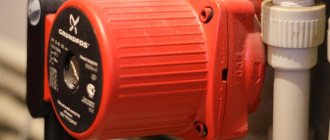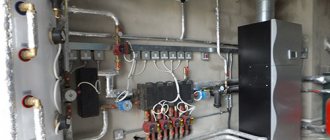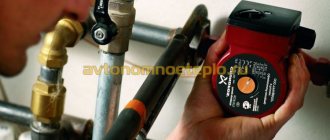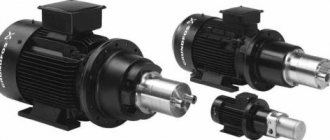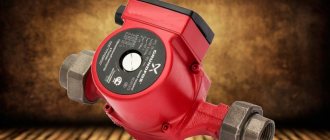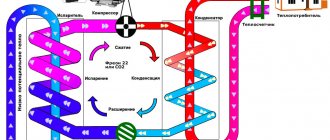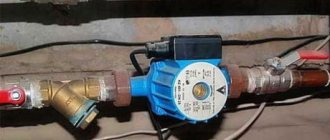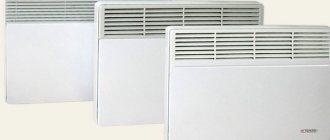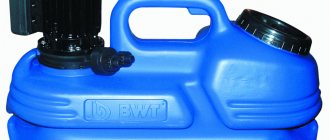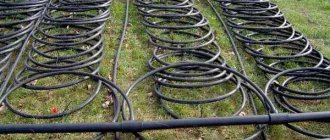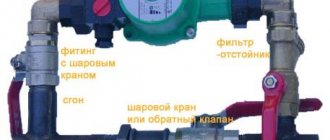Despite the widespread use of heating systems with natural coolant circulation, they have a number of serious disadvantages. These include the low speed of fluid movement, which negatively affects the final temperature in the return circuit. It should also be mentioned that not all radiators receive the same amount of hot water. Such shortcomings do not allow the house to be provided with sufficient heat.
However, today this problem can be solved if the heating system operates in combination with a circulation pump . Here the problem arises: which one to choose? If you turn to specialists, then, in their opinion, the best option among all the options offered is the Grundfos UPS pump.
history of the company
The starting point for Grundfos should be considered 1945.
It was then that, on the initiative of the Danish engineer Paul Du Jensen, a small production was founded, which was called “Bjerringbro Pressestoberi og Maskinfabrik”. If you try to translate it, in Russian it will sound like the Bjerringbro injection molding and machining factory. During the first years of the company’s operation, the engineer devoted all his efforts to the creation and production of only one product - pumping equipment. Thanks to the high quality of the products, as well as a non-standard approach to solving most problems regarding design features and dimensions, it did not take the company very long for the manufactured units to become highly popular. As production capacity increased, more and more consumers chose products under this brand.
Until 1967, the company changed its name several times. And only this year the name Grundfos was assigned to it, by which today the manufacturer of high-quality pumps is recognized.
If we look at world statistics, then the share of pumping equipment manufactured under the Grundfos brand accounts for about 50% of global consumption. The reasons for this situation are not only related to high quality. This was also facilitated by the fact that the company today represents an international concern. In many countries there are plants, factories and small assembly shops created on the initiative of Grundfos management. They are also available in our country. Thus, in the Russian capital in 1992, a representative office of the company appeared , which later received the status of a subsidiary, the first decision of which was to launch a plant near the city of Istra.
Types of devices
If we consider the company’s assortment, we can distinguish the following types of grundfos pumps:
- With dry rotor.
- With wet rotor.
With dry rotor
One of the features of this type of pumping equipment is its high efficiency. In addition to this, it has great power. Similar models of Grundfos pumps are designed to work with large volumes of liquid .
For this reason, they are common in manufacturing plants or used in heating systems of large buildings. But for private residential properties they are used extremely rarely. If we consider the design of this device, then it eliminates contact of the rotor with the liquid, which determines the name of these pumps. The separator between this part and the chamber in which the liquid circulates is a cuff.
When operating Grundfos dry-type circulation pumps, it should be taken into account that they create a lot of noise. This is due to the presence in their design of a special fan, which during rotation ensures cooling of the device body .
With wet rotor
If we consider heating systems for private residential properties, then the best choice for them would be the Grundfos UPS pump. Let's try to decipher the abbreviation of this device: UP indicates that this model represents a class of circulation pumps, S gives a hint that the device uses a three-speed switching system. In other words, during operation of the grundfos circulation pump, the owner can choose any of three speeds, which can be switched mechanically or automatically.
Compared to devices of the previous type, installations equipped with a wet rotor are distinguished by high efficiency , the value of which reaches 50%. Its advantages include the absence of noise during operation. True, for effective use, the system must supply high-quality coolant. If this requirement is met, you can expect that the grundfos pump will be able to effectively cope with its task for at least 10 years.
According to experts, the best choice for the heating system of a private home is a Grundfos pump with automation. This will allow the owner to choose the desired operating mode for several days. In addition, when using such a pump, energy consumption will be low. An important point is that there is no need to carry out maintenance activities for such equipment. You just need to set the necessary settings for the device, after which you will not need to change anything in the equipment.
Pump replacement
Replacing a pump that has exhausted its service life sometimes causes problems, since the same pump may well have been discontinued during its operation, and the replacement recommended by the manufacturer may differ significantly in connection dimensions. And even if there are no such problems, in any case it is advisable to consider other replacement options. The development of pumping equipment does not stand still, new manufacturers are entering the market, competition is forcing manufacturers to optimize pumping equipment. As a result, to replace a pump that has exhausted its service life, another one may appear, more suitable for specific technical conditions and significantly cheaper.
As an example of the feasibility of such a replacement, I usually cite the possibility of replacing flanged circulation pumps with a wet rotor with the same characteristics, only with a dry rotor. The price gain can be more than double. At the same time, pumps with a dry rotor have advantages in the form of higher efficiency and maintainability. The disadvantages of such a replacement include the need to rework the pipeline, because in most cases the connecting dimensions will be different and the need to install vibration-damping inserts if the heating system is implemented with steel pipes and the distance to living quarters does not compensate for the vibration that occurs during operation. However, the cost of solving these problems often does not compare to the price difference.
Another typical option for replacing an old pump with a new one is to replace a flanged cantilever pump on a slab with a flanged close-coupled pump. Old Soviet-made cantilever pumps did not have such high efficiency as modern ones; in addition, they were designed and installed with a significant margin, and correct replacement of such a pump will lead to significant energy savings.
Modern well pumps are more flow optimized than older ones. And where pumps with a diameter of 6-8 inches were previously used, it is now quite possible to use pumps with a diameter of 4-6 inches, which are cheaper.
A reasonable approach to replacing a pump that has reached the end of its service life, in most cases, leads to cost savings, reduced operating costs and an increase in the time until the next replacement.
JP (Grundfos)
VA 50, VA 60 (DAB) CA (Calpeda) DG Blue, DG BluePRO (Zenit) TCR (Lowara) EURO, EUROINOX, EUROCOM (DAB)
Technical characteristics overview
You can get an idea of the technical characteristics of the device using the example of one of the manufacturer’s models, which can be the Grundfos UPS 25-40ST pump . This device is in fairly high demand among owners of country houses.
If you analyze the numbers present in the marking, you can understand that the model is equipped with pipes with a diameter of 25 mm, having a pressure of 4 m. This product is capable of ensuring the efficient operation of the heating systems of a one-story house.
If the heating is presented in the form of a single-pipe system, then such a Grundfos circulation pump can successfully perform its functions in a two-story house.
Stages and rules of repair
Repair of the Sololift pump, as well as repair of a Grundfos pumping station for any purpose, can be done independently, having first identified the source of the problem.
Equipment diagnostics involves several stages:
- start the pumping station, assess the noise and vibration levels;
- check the pressure indicators;
- make sure that the motor does not overheat during operation;
- check the presence and quality of lubrication of node connections;
- make sure the integrity of the structure and the absence of leaks;
- inspect the box for secure fixation of the terminals.
If you are sure that the malfunctions are not caused by lime deposits and contamination, overloads or operation at maximum power, the pump can be disassembled. When planning to repair the Grundfos pump yourself, make sure that the water is drained from the pipelines and turn off the system. Disassembly begins with the junction box and visual assessment of components. As a rule, such an inspection makes it possible to immediately detect a burnt out or worn out part. If not, we will continue to disassemble the installation.
The engine must be in a vertical position during disassembly . This will prevent the risk of oil leakage. To diagnose the starting mechanism, you must connect an ohmmeter to the engine. This instrument, when rotating the handle, generates a voltage in the range of 200-300 V, sufficient to take readings on a resistance meter. Diagnostic data that is too high, reaching infinity, indicates a break in the working phase, too low - an interturn short circuit. Independent adjustment of operating parameters with such deviations is impossible.
Grundfos circulation pump: repair review (video)
Circulation pumps have proven themselves to be excellent in heating systems. Structurally, the pump has a very similar structure to the pump design. As a rule, the casing of pumping equipment is made of fairly strong and corrosion-resistant materials (brass, bronze, cast iron, stainless steel). This material is able to interact well with both aggressive environments and high temperatures.
Design features
For the manufacture of certain parts of the grundfos pump, different materials can be used: cast iron is used for the pump body, aluminum is used for the motor.
The material used for the impeller and bearings is ceramics, and for the rotor of a solid design – steel. When choosing each of these materials, their characteristics were taken into account. Thanks to them, these elements demonstrate high strength and cope well with coolant heated to high temperatures. First of all, you should highlight the bearings. Even if the pump is used in particularly harsh conditions, ceramic bearings can operate without a single repair for up to 10 years. In addition, the use of ceramics provides the advantage of reducing noise during rotor rotation.
If we evaluate the manufacturer’s assortment, it includes models of grundfos circulation pumps equipped with a technopolymer impeller and a ceramic rotor. Through the use of such innovations, it is possible to significantly increase the efficiency of the installation and extend its operational life. These features should be remembered by those for whom it is important to install a high-quality device into the heating system.
Features and benefits of pumps
The main advantages of Grundfos pumps are:
- The optimum ratio of price and quality,
- high energy efficiency of equipment,
- a huge selection that can satisfy any need.
- quite long service life,
- good technical support.
When choosing pumping equipment, the following technical parameters must be taken into account:
- At Grundfos, the designers have thought through in advance almost all possible problems that may arise in a particular field of operation, therefore, when choosing equipment from this manufacturer, you get a unit that takes into account many years of experience.
First, you need to decide what type is needed. In total, there are three large groups: for wells, for heating, for drainage or sewerage. At Grundfos, designers have thought through in advance almost all possible problems that may arise in a particular area of operation. Therefore, when choosing equipment from this manufacturer, you get a unit that takes into account many years of experience. - Before ordering equipment, you need to decide what type of voltage will be used: single-phase or three-phase. For household pumps, single-phase pumps are mainly used; in industry, three-phase pumps are more commonly used.
- The main characteristic when choosing a pump is the graph of pressure versus flow. This graph shows how much water the pump will pump depending on the required pressure. The higher the pressure that needs to be maintained, the less water the pump can pump. When choosing equipment, the required operating point must be under its curve. It is also necessary to provide a margin of 20% for the supply.
- Power is also an important parameter. It depends on the current and voltage. This parameter is taken into account when selecting pump protection, as well as when calculating the required cross-section of power supply cables. The higher the power, the greater the productivity.
- When choosing pumps, it is also necessary to take into account geometric parameters and connection dimensions. Before placing an order, you must make sure that the selected equipment is suitable both in weight and dimensions.
- Depending on the operating conditions, it is necessary to pay attention to the minimum and maximum permissible temperature of the pumped medium. There are cases when the wrong choice of range led to equipment failure.
- Also, when choosing from equivalent pumps, you need to choose the one with a higher efficiency rating. In the long term, such equipment will provide significant energy savings.
In order for the unit to work for a long time and without interruptions, it must be installed correctly. Installation of any equipment must be carried out strictly according to the attached installation instructions. Also, do not forget about installing automated control systems for pumps.
Such a system will protect your unit from power surges, from engine overheating, from the possibility of working without water, from water getting inside, etc., and will also allow you to control the process automatically, without human intervention.
Another condition for durability is proper operation. It is also stated in the instructions.
It is important to understand that if a pump unit protection system is installed, then you need to be alert when it is triggered. It is best to carry out a full cycle of equipment inspection.
What to pay attention to during installation?
A difficult point at the installation stage is the correct choice of the direction of the pipes.
However, there will be no problems with this due to the fact that the manufacturer has taken the necessary measures that will simplify the solution of this problem. If you look at the pump body, you can see an arrow corresponding to the rotation of the rotor. From it you can understand in which direction the coolant is moving. Please note that the circulation pump is sold without mounting hardware . Therefore, you will have to buy them separately. Having completed the installation of the circulation device, you should pause for a day, and then you can start the pump. This must be done for the reason that the operation of circulation pumping equipment must take place exclusively at positive indoor temperatures. If before purchasing the pump it was located or transported in the cold, then without natural heating of its component elements during startup there is a risk of its breakdown.
To connect the device to the AC network, it is advisable to use a separate cable separated from the distribution panel. If you use the Grundfos UPS 25-40 model, you can choose a three-core copper cable with a cross-section of one core of 0.75 mm2.
Rating of popular models
Most often, this model is counterfeited by scammers, since it sells better.
The pump rating is based on a comparison of the technical indicators and operational capabilities of three models. In first place is the Grundfos UPS 25-60 (N) 180 product, which is a circulation unit with a cast iron body (this option is used only for heating). Its modification for hot water supply has a stainless steel body. All samples are equipped with a single-phase asynchronous motor, a speed switch and a special sleeve separating the rotor and stator.
The advantages include:
- permissibility of use in any type of circuits (closed and open);
- wear resistance and efficiency (consumption no more than 60 W);
- low noise level (up to 43 dB);
- compactness, low weight and overheating protection;
- ease of installation and maintenance;
- long service life.
The disadvantages of these products are the obsolescence of individual models and their high cost.
The second position is occupied by a Grundfos ALPHA2 25-40 180 , equipped with a built-in permanent magnet electric motor. The power consumed by this device from the network is 0.022 kW, and the productivity is 2.4 m3/hour. At an operating temperature of the coolant from +2 to +110 °C, the pressure created in the circuits is 4.0 meters.
The Alpha model is made of cast iron and has an increased service life
This product has a pure cast iron body and is equipped with an efficient wet rotor motor and ALPHA plug. Vertical or horizontal installation of the unit is allowed, which, after startup, is controlled via built-in electronics. All information about the possible operating modes of the device, its energy consumption and typical breakdowns is displayed on the display located on the front panel.
The positive aspects of this model include:
- Low power consumption (only 22 watts).
- Small dimensions (10x15x18 cm) and light weight (2.1 kg).
- Low noise level during operation (no more than 43 dB).
- Protection from corrosion (the body is made of stainless steel).
- The presence of the AUTOADAPT function, as well as the ability to select night or summer mode.
- Low level of heat loss (the housing is insulated with a protective casing).
- Possibility of setting fixed operating modes.
- Long-term warranty (up to 5 years).
The disadvantages of this product are the frequent malfunctions of the electronics, as well as the lack of special protection against dry running.
The third place is confidently occupied by the Grundfos UPA 15-90 (N) - a modern monoblock type unit, which has characteristics slightly worse than the previous model.
Review of other models
There are also other models on the market under the Grundfos brand:
- Magna.
- Alpha.
Magna
The model of this pumping equipment is presented in three classes: large, medium and small pumps. If we are talking about the heating system of a private house, then you should choose a device that represents the last two groups.
The model is distinguished by the fact that it is capable of equally effectively supporting the operation of the heating system, hot water supply, and air conditioning. The design includes a control unit, the function of which is to control the temperature and pressure created in the heating system. The main purpose of low-power pumps is to use them to ensure the efficient operation of heated floors.
Alpha
When developing this model, the latest achievements of the company were used, thanks to which the need to use manual and automatic adjustment methods disappeared. In other words, the company managed to create a “smart pump”. After installation, this equipment independently determines the preferred operating mode. The owner can rest assured that the device will choose the most suitable option. When using such a unit, it is possible to ensure not only efficient distribution of heat throughout the premises, but also reduce fuel and electricity costs.
During operation, the device monitors heating changes, adapting its operating mode to them. The owner has the opportunity to independently select values for certain mode parameters. For example, it is possible to provide that the pump reduces fuel consumption at night, as well as during those hours when there are no people in the house. In addition to this, the electricity supply system is equipped with a special unit, the function of which is to convert the frequency of the current.
Heating pump installation technology
The question of how to install a heating pump is quite relevant today. After all, hiring a specialist to install pumping equipment is an additional expense. Therefore, many people decide to install the unit themselves in order to save a little money.
But it should be noted that installing a centrifugal pump in a heating system is not an easy task. Here it is important to follow certain rules, thoroughly know the installation technology, and take into account a number of nuances. Otherwise, during the operation of the updated system, serious problems may arise, the solution of which will require a lot of financial resources.
Since installing a water pump in a heating system is a complex process, it is worth considering it in more detail.
Preparatory work
It is necessary to buy all the required parts and prepare the tools. Before you install a heating pump, you need to buy it. We need to decide on the power of the unit. You should not buy a device that is too powerful. It will still not be used at full strength. And the device will be noisier.
The power must be selected based on the area of the room and the length of the pipeline.
For example, for every 10 m of pipeline, 0.6 m of head is required. It should also be taken into account that the pump power should be 10% higher than the value that was calculated for a specific room. Today there are different types of pumping units on sale. Any circulation pump for heating, installed correctly, will solve a number of problems and increase the heat transfer of the system.
Some models of circulation pumps are equipped with a manual or electronic regulator of the speed of rotation of the electric motor shaft. Thermal valves allow you to regulate the room temperature based on the set parameters. Pumps with built-in electronics allow smooth adjustment of pressure differences. Experts advise buying a pump with split-type threads. If they are missing, you will have to purchase these parts. All threads must be equipped with gaskets. Gaskets must be treated with sealant in advance. In addition, you will also need a deep cleaning filter. Install such a filter in front of the pump. You can read more about choosing heating pumps here. To normalize the operation of the heating system, a check valve is prepared before installation.
The tools you will need are: shut-off valves, special keys, and a pipe. The pipe size should be small. Its diameter must correspond to the diameter of the riser.
Choosing a location for installation
Before installing a heating pump, you need to decide on its location. Modern models of circulating pumps can be installed not only on the water supply pipe, but also on the return pipeline. A bypass is a jumper installed between the direct and return wiring of the heating battery. If the installation is carried out on a bypass, then the device must first be checked. It must be able to withstand strong pressure of hot water.
In houses with a “warm floor” system, the heating pump is installed at the point of hot water supply. In this way, the possibility of air pockets appearing in the pipeline can be eliminated. If there is a membrane tank, a bypass with a pump is installed in the return pipeline. It is better to install it closer to the expansion tank.
Today, in practice, several methods are used for arranging pumping devices in a heating system. The most optimal option is selected based on the type of boiler used, expansion tank, type of heating system and the presence of additional elements.
Pump installation
Once the location has been chosen, you can install heat pumps to heat your home. The entire installation process is described in detail by the manufacturer in the instructions that come with each pumping device. Therefore, this document must be read carefully. The heating system can be made of ecoplastic or metal. In both cases, installation of the pump in the heating system is carried out in the same way. The pump device is inserted by bypass. For a metal pipeline, you can buy a ready-made structure to bypass the main line.
The heating structure must be washed several times. And then drain the water completely. After this, a U-shaped piece of pipe with a pump built into the middle is installed on the side of the main pipe. Ball valves are mounted on both sides of the device. If you turn off one of the taps, the natural circulation of coolant in the pipeline will be restored. And if the circulating equipment needs to be repaired or replaced, then there is no need to drain the water from the system - just turn off both taps. When installing a water heating pump, you need to pay attention to the fact that there is an arrow on the body of the unit that indicates the direction of water movement. This helps to install the device correctly.
When the installation of the pump in the heating system is completed, the system is refilled with coolant. It is necessary to carefully check its performance. At this stage, all errors and defects can still be corrected. If everything is in order, excess air must be removed from the pipeline. This is done using a central screw. When water starts to come out of the hole, all unnecessary air has escaped. If the pumping device has a manual control type, then the air will need to be removed before each start of work.
Electrical connection of pumping equipment
After the installation of the pump in the heating system of the house is completed, it is connected to the electrical network. In this case, the possibility of moisture or condensation entering the terminal box should be excluded. If the temperature of the coolant in the battery rises by more than 90 degrees, use a heat-resistant cable. It should not come into contact with the motor and pump housing, or with the walls of the pipes. Can be connected on the right or left side. If the terminal box is located on the side, the cable is inserted from the bottom. When connecting to the network in structures with natural circulation, an automatic fuse is used. Thanks to it, you can turn it off. Its installation is usually carried out at a distance of 0.5 meters from the boiler.
If the pump is connected to a system with forced circulation, then it begins to work as soon as a special thermal relay reacts. Therefore, for simultaneous operation of the additional and built-in devices, the first one should also be connected to the relay or to the second unit in parallel. To ensure uninterrupted operation of the pumping device and other volatile elements, it is worth installing an uninterruptible power supply. It would also be a good idea to purchase a relay for the heating pump, which will turn on the equipment as soon as the pressure in the system drops below a certain level. And if the pressure in the radiator reaches the upper limit, the relay will turn off the pump.
To connect the pump, use only a grounded outlet.
This will ensure safe operation of the device. In electric boilers, the pumping device is connected to the boiler. Thanks to this, the pump starts working when the water is heated.
By understanding how to properly install a heating pump, you can quickly and effectively solve the problem of uneven heating of the room and avoid the formation of air locks. The main thing is to take into account all the nuances and strictly follow the installation technology. If you don’t know how to install a heating pump, it is better to entrust such work to a professional technician. After all, the slightest mistake can lead to unpleasant consequences.
